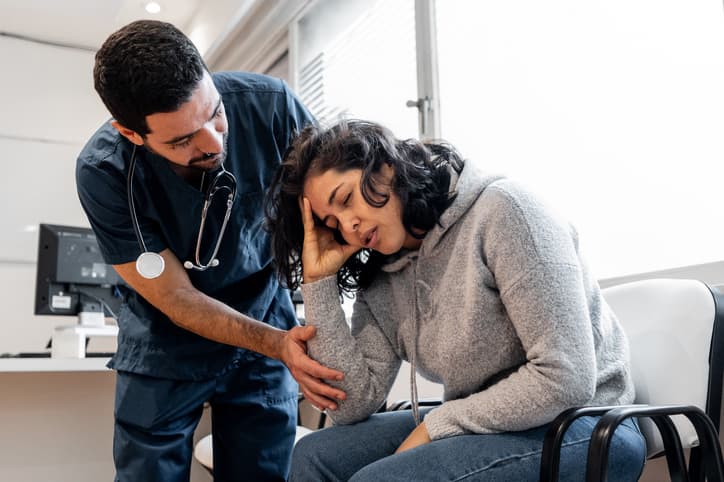Sepsis

What is sepsis?
Sepsis is the body’s extreme response to an infection that damages vital tissues and organs. It is a medical emergency that can cause organ failure and death if not treated quickly.
Sepsis survivors have a high risk of getting sepsis again. If you have symptoms of an infection that are getting worse, seek medical care immediately. Tell your healthcare provider that you have a history of sepsis and ask if your current infection could be leading to sepsis. If you experience rapid breathing, fast heart rate, severe confusion, or extreme pain, call 911 or go to the nearest emergency room.
Understanding Sepsis
People with sepsis experience one or more of the following:
- Confusion or change in mental status
- Fast or shallow breathing
- High heart rate
- Fever, shivering, or feeling extremely cold
- Sweaty or clammy skin
- Extreme pain
Any person with an infection can develop sepsis. The people at the highest risk for sepsis include:
- Adults 65 years and older
- Children younger than 1 year old
- Immunocompromised people (i.e. cancer, Lupus, HIV/AIDS, kidney disease)
- People with central lines, Foley catheters, feeding tubes, or implantable devices
- People with burns, ulcers, or trauma
- People with recent hospitalizations, surgeries, or extreme illness
- People who survived sepsis
Any type of infection can lead to sepsis. If you have an infection or wound that is not getting better, see a doctor.
Schedule an appointment online
Call 911 or seek emergency care immediately if you suspect sepsis or experience any of the following symptoms:
- Rapid breathing
- Fast heart rate
- Severe confusion
- Extreme pain
Tell the doctor that you are concerned about sepsis.
Sepsis can be caused by any type of infection, including viral, bacterial, or fungal infections. The most common sites of infection include:
- Lungs (i.e. pneumonia)
- Skin (i.e. burns, wounds, cellulitis)
- Bloodstream
- Brain or spinal cord
- Gastrointestinal System (i.e. appendicitis, peritonitis, gall bladder or liver infections)
- Digestive system
- Kidneys, bladder, or other parts of urinary system
- Catheter sites
Sepsis Treatment and Recovery
Sepsis
Sepsis is the body’s extreme response to an infection. It is a medical emergency that requires early identification and treatment.
Septic Shock
Septic shock occurs when the body’s organs begin failing. Blood pressure drops to dangerously low levels, which disrupts the flow of oxygen throughout the body. People in septic shock are at high-risk for death by sepsis.
- IV Antibiotics: To treat the source of infection, doctors will give IV antibiotics so that they can get into the bloodstream quickly.
- Fluids: Patients will be given fluids if their blood pressure drops too low to help maintain blood flow to the body’s vital organs.
- Vasopressors: For patients that have dangerously low blood pressure after receiving fluids, vasopressor medications are given to tighten the blood vessels and reach an adequate blood pressure.
- Oxygen: For patients that are having difficulty breathing, they may be given an oxygen mask or get intubated, meaning inserting a breathing tube into the trachea.
- Wash your hands
- Seek medical care immediately if you suspect an infection
- Keep cuts or wounds clean and covered until they are healed
- Maintain good hygiene
- Receive routine medical care for chronic conditions
- Get recommended vaccines
After having sepsis, it is helpful to work with a healthcare professional and your loved ones to develop a recovery plan. For many people, rehabilitation will start the hospital starting with daily life activities such as sitting, standing, walking, and bathing.
A recovery plan will also include some these items:
- Eating a healthy diet
- Learning about sepsis to understand what your body experienced
- Share your experience with people you trust
- Setting small goals for recovery each week
- Exercising when feeling well enough to do so
- Resting when you need it
- Seeing your doctor regularly
It is important to discuss any concerns that you have with your doctor about symptoms you are experiencing after having sepsis.
- Many survivors of sepsis experience physical symptoms, such as difficulty moving, body aches or pains, weakness or fatigue, hair loss, difficulty sleeping, brittle nails, weight loss, reduced appetite, or difficulty breathing.
- Mental health symptoms after sepsis may include feelings of depression, anger, anxiety, flashbacks, confusion, frustration, poor concentration, lack of motivation, or isolating yourself from others.
Resources
Sepsis Alliance
- Education for Patients' Families and Caregivers - Explore resources to help navigate the complex journey of caring for someone with sepsis.
- When It Comes to Sepsis, Remember, IT'S ABOUT TIME™ - Review helpful information for recognizing sepsis and watch inspiring patient recovery testimonials.
- Sepsis Alliance Connect - Join Sepsis Alliance Connect, a virtual support community designed for the millions of people affected by sepsis.
- Pediatric Sepsis - Understand the prevalence and risk of sepsis in children, which is especially harmful in premature babies and infants.
